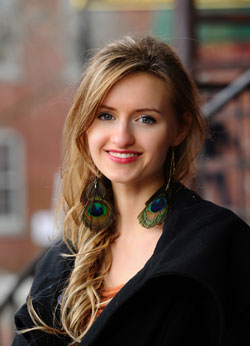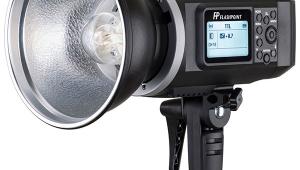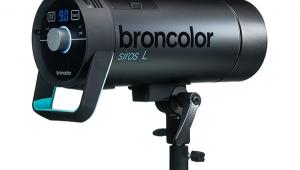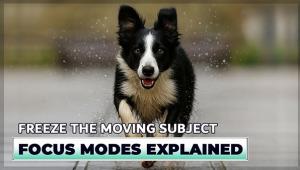How is $400.00 + affordable to starving artists?
F&V K4000 LED Studio Panel: Quality Light At An Economical Price
Portrait photographers are constantly looking for new lighting gear that will make their lives easier and produce great results. And while flash photography has been the studio standard for many years, it’s always been more difficult to previsualize the final effect since the image you see using the modeling lights is not always the same you see once the flash fires. The instant feedback of digital cameras has lessened that worry some, but you can still be in for some surprises. The new breed of LED lights eliminates most of these concerns with true WYSIWYG lighting, and with that in mind I was eager to check out F&V’s new K4000 LED Studio Panel to see how it could be used in my work.



Photos above courtesy of F&V
The K4000 Kit & Specs
The light itself is a thin panel that is 12 inches square, or a “1 by 1” light. This type of light is used every day in TV stations across the country and for many other video applications. The K4000 I tested is daylight-balanced; there is also a K4000S model that offers variable color temperature from 3200K to 5600K.
The back of the light has a rheostat, an on-off switch, a V-Mount plate where you can attach either a V-Mount battery or the AC adapter, and connections that allow multiple panels to be connected and controlled together. Battery life is estimated at about five hours.
I tested the 3-Light Kit, which also includes a sturdy case. Each light I worked with came with a milk-white diffusion panel that is attached by four rods that sit it about 2” in front of the light. Be careful not to lose the tiny nuts that hold it in place!
The unit has 400 LEDs that measure 2860 lux, according to the manufacturer. To put that in terms that most photographers will understand, I conducted some measurements in my studio. I set my light meter at ISO 400 and 1/15 sec and took readings at both 6 feet and 10 feet at ISO 400. At 6 feet my reading was f/9; at 10 feet the reading was f/5.6. I also took readings with the diffusion panel attached and determined that it reduced the light by two-thirds of a stop. These readings were taken at full-power output; you can dim the lights using the rheostat and I found when I did that, to my eyes, dimming was seamless and flicker free.
Color Balance
One of the biggest concerns of LED light panels is getting accurate color temperature. I’ve heard that many inexpensive units vary greatly from one unit to another and many have a green color cast. The color accuracy of these types of lights is measured by using the Color Rendering Index (CRI). These lights have a rating of 85 percent. The sun is 100 percent. I do not have a color temperature meter so I did not have an accurate method of measuring this, but I did all of my testing shooting a daylight color balance and found the color to be quite pleasing and did not need to be corrected in post-processing. Of course, shooting in Raw and adjusting color after is always a good procedure, but in this case I found that this was not necessary and that colors were very accurate.
Let’s take a look at the milk-white diffusion panel, because if you’re a portrait photographer you’ll be using this a lot. It really softens the light a great deal plus you have one big light instead of 400 little pins of light as a source. I got on the subject side of the light and it makes a big difference.

All Photos below © Steve Bedell


At Work
So now that we have some idea of what we’re working with here, let’s get right to the matter at hand: can a portrait photographer use these lights on a daily basis both in the studio and on location? The answer, as always, depends on what you want to do with them.
First, I wanted to see if I could use these lights for studio portraits. The answer is yes, as long as we’re not talking big groups and as long as we’re keeping subject and light relatively close to one another and as long as there isn’t a lot of movement. So, my scorecard is: individuals or couples, great; groups and babies, not so much.
My next big question was how they would perform in outdoor and low-light-level situations. I know photographers who are using “1 by 1” lights to do outdoor portraits in the shade and overpowering the ambient light by 1/2 to 1 stop, using them as a main light. This eliminates issues such as color contamination and poor catchlights, among others, and also allows much more flexibility in choosing locations than using daylight alone. Plus, by having the ambient light act as a fill light, you don’t notice the drastic light falloff you get in the studio. Add a second light panel as an accent light from behind and you can create very nice lighting very quickly almost anywhere. And you eliminate all the complications of using flash outside. This is a very big plus with the light panels.
Most of my testing was done in the middle of a particularly snowy and cold New Hampshire winter, but I did get a chance to test during a program I was giving on a milder day in Connecticut; kudos to the other brave souls who ignored the cold and ventured outside with me. I did not have batteries but I plugged up the two panels to my Paul C. Buff Vagabond II power supply and it worked perfectly with that. Check the pics and captions for results.


Overall, I believe the K4000 panels will be a welcome addition to any portrait photographer’s lighting kit, both in the studio and on location. They are lightweight, very portable, especially when battery equipped, and provide clean, consistent light. They are also obviously a good choice for still life studio shooting and video. F&V told me they are going to be bringing out more LED lights soon, some with higher CRI ratings, so check their website for news.
For more information and full specs, contact F&V at www.fvlighting.com.
Prices
K4000 LED Studio Panel: $415
K4000S LED Studio Panel: $499
3-Light Kit with Case: K4000, $1050; K4000S, $1299
Steve Bedell has been a portrait photographer for over 25 years. To subscribe to EPhoto, a free e-mail newsletter with tips for photographers, contact Bedell via e-mail at: smbedell@gmail.com. Also ask about his lighting DVDs.
- Log in or register to post comments


















































